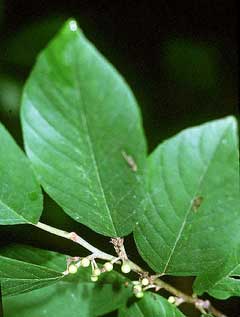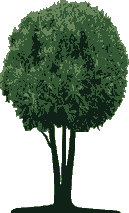 |
|
Carl Hunter. USDA SCS. 1991. Southern wetland flora: Field office guide to plant species. South National Technical Center, Fort Worth. |
 |
| USDA Plant Database |
Translate this page:
Summary
Bloom Color: Yellow. Main Bloom Time: Early spring, Late spring, Mid spring. Form: Oval.
Physical Characteristics

 Rhamnus carolinianus is a deciduous Tree growing to 12 m (39ft 4in) at a slow rate.
Rhamnus carolinianus is a deciduous Tree growing to 12 m (39ft 4in) at a slow rate.
See above for USDA hardiness. It is hardy to UK zone 6. It is in flower in May, and the seeds ripen in September. The species is hermaphrodite (has both male and female organs) and is pollinated by Insects.
Suitable for: light (sandy), medium (loamy) and heavy (clay) soils. Suitable pH: mildly acid, neutral and basic (mildly alkaline) soils. It can grow in semi-shade (light woodland) or no shade. It prefers moist soil.
UK Hardiness Map
US Hardiness Map
Synonyms
Frangula caroliniana.
Plant Habitats
Woodland Garden Canopy; Secondary;
Edible Uses
Edible Parts: Fruit
Edible Uses:
Fruit - raw or cooked. The fruit has a thin rather dry flesh[82] with a sweet and agreeable flavour[2, 11, 105, 229]. The fruit is about 7 - 10mm in diameter and contains 2 - 4 small seeds[229]. Some caution is advised, see the notes above on toxicity.
References More on Edible Uses
Medicinal Uses
Plants For A Future can not take any responsibility for any adverse effects from the use of plants. Always seek advice from a professional before using a plant medicinally.
Hepatic
A tea made from the bark is emetic and strongly laxative[222]. It is used in the treatment of constipation with nervous or muscular atony of the intestines[222]. An infusion of the wood has been used in the treatment of jaundice[257].
References More on Medicinal Uses
The Bookshop: Edible Plant Books
Our Latest books on Perennial Plants For Food Forests and Permaculture Gardens in paperback or digital formats.

Edible Tropical Plants
Food Forest Plants for Hotter Conditions: 250+ Plants For Tropical Food Forests & Permaculture Gardens.
More

Edible Temperate Plants
Plants for Your Food Forest: 500 Plants for Temperate Food Forests & Permaculture Gardens.
More

More Books
PFAF have eight books available in paperback and digital formats. Browse the shop for more information.
Shop Now
Other Uses
Wood
Wood - rather hard, light, close grained, not strong[82]. It weighs 34lb per cubic foot[227]. Too small to be of commercial value[229].
Special Uses
References More on Other Uses
Cultivation details
Landscape Uses:Border, Erosion control, Pest tolerant, Standard, Specimen. Succeeds in any reasonably good soil[11], whether moderately acid or alkaline[149]. Prefers a moist moderately fertile soil in sun or partial shade[200]. One report suggests that the plant might not be very hardy in Britain[11], whilst another says that it is in climatic zone 6 and thus tolerates temperatures down to about -15°c[200]. A slow-growing and usually short-lived plant in the wild[229]. Plants are susceptible to 'crown rust' of oats[149]. The species in this genus are notably resistant to honey fungus[200]. This species is closely related to R. purshiana[11]. Special Features:
North American native, Inconspicuous flowers or blooms.
References Carbon Farming Information and Carbon Sequestration Information
Temperature Converter
Type a value in the Celsius field to convert the value to Fahrenheit:
Fahrenheit:
The PFAF Bookshop
Plants For A Future have a number of books available in paperback and digital form. Book titles include Edible Plants, Edible Perennials, Edible Trees,Edible Shrubs, Woodland Gardening, and Temperate Food Forest Plants. Our new book is Food Forest Plants For Hotter Conditions (Tropical and Sub-Tropical).
Shop Now
Plant Propagation
Seed - best sown as soon as it is ripe in the autumn in a cold frame. Stored seed will require 1 - 2 months stratification at 5°c and should be sown as early in the year as possible in a cold frame[200]. Prick out the seedlings into individual pots when they are large enough to handle, and grow them on in the greenhouse or cold frame for their first winter. Plant them out in late spring or early summer of the following year. Cuttings of half-ripe wood, July/August in a frame[113]. Cuttings of mature wood of the current year's growth, autumn in a frame. Layering in early spring[4].
Other Names
If available other names are mentioned here
Native Range
Coming Soon
Weed Potential
Right plant wrong place. We are currently updating this section.
Please note that a plant may be invasive in one area but may not in your area so it's worth checking.
Conservation Status
IUCN Red List of Threatened Plants Status :

Growth: S = slow M = medium F = fast. Soil: L = light (sandy) M = medium H = heavy (clay). pH: A = acid N = neutral B = basic (alkaline). Shade: F = full shade S = semi-shade N = no shade. Moisture: D = dry M = Moist We = wet Wa = water.
Now available:
Food Forest Plants for Mediterranean Conditions
350+ Perennial Plants For Mediterranean and Drier Food Forests and Permaculture Gardens.
[Paperback and eBook]
This is the third in Plants For A Future's series of plant guides for food forests tailored to
specific climate zones. Following volumes on temperate and tropical ecosystems, this book focuses
on species suited to Mediterranean conditions—regions with hot, dry summers and cool, wet winters,
often facing the added challenge of climate change.
Read More
Expert comment
Author
Walter.
Botanical References
1143200
Links / References
For a list of references used on this page please go here
Readers comment
| Add a comment |
|
If you have important information about this plant that may help other users please add a comment or link below. Only comments or links that are felt to be directly relevant to a plant will be included. If you think a comment/link or information contained on this page is inaccurate or misleading we would welcome your feedback at [email protected]. If you have questions about a plant please use the Forum on this website as we do not have the resources to answer questions ourselves.
* Please note: the comments by website users are not necessarily those held by PFAF and may give misleading or inaccurate information.
To leave a comment please Register or login here All comments need to be approved so will not appear immediately.
|
Subject : Rhamnus carolinianus
|
|
|
|